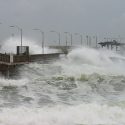Lake research offers clues to managing crayfish invasions

A male rusty crayfish, or Orconectes rusticus, found in Sparking Lake in northern Wisconsin. Rusty crayfish are an invasive species now found in lakes and streams across the United States. (Photo by: Brian Roth)
Rusty crayfish, an invasive species now crawling across the rocky bottoms of lakes and streams throughout the United States and Canada, may not always have a stronghold once they enter these bodies of water.
The findings, part of an ongoing study at UW–Madison, suggest that the type of interaction among rusty crayfish, fish and aquatic plants may tip the scale, favoring either the invader or native species. This knowledge, the researchers note, may lead to new strategies for removing these trespassers.
Details of the research will be presented Wednesday, Aug. 4, at the annual meeting of the Ecological Society of America in Portland, Ore.
Native to the streams of Ohio, Kentucky and Tennessee, rusty crayfish – measuring up to five inches long – have slowly infiltrated lakes far and wide, including those in New Mexico and Ontario.
Once used for bait, rusty crayfish now are partly responsible for anglers’ declining number of fish catches because they alter fish habitat, ultimately altering fish populations.
For example, these intruders eat fish eggs, displace animals native to the waters and “mow down” aquatic plants – a source of food and shelter for fish, says Brian Roth, a graduate student at UW–Madison’s Center for Limnology and a presenter at the meeting. “They have really dramatic and traumatic effects on the ecosystem.”
To date, the promise of successfully removing rusty crayfish and restoring the habitat has been bleak. For example, bait traps tend to catch only the largest rusty crayfish, and biocides, chemicals proven to wipe them out, obliterate everything else in the lake.
But one strategy for managing these invaders once they enter a lake might come from Roth’s preliminary data showing that lakes – even ones similar in water chemistry and the amount of rocky substrate crayfish call home – can have either a low or high abundance of these invaders.
Donning his scuba gear, Roth went underwater to better understand why rusty crayfish are more abundant in certain lakes. During a three-year period, he surveyed six lakes and collected the rusty crayfish that crawled across the rocky bottom in each sampling area. The number of crayfish ranged from just five per square meter in one lake to around 200 in another, the majority of which were newborn crayfish.
Roth and his collaborators then compared the number of crayfish in each sampling area to data collected by another UW–Madison group studying the number of fish and aquatic plants in those same areas.
They found that two of the testing lakes, just five miles apart and similar in water chemistry, looked very different underwater in terms of rusty crayfish, fish and plant life. While Big Lake had a high abundance of the invasive species, but low abundance of bluegills and plants, Wild Rice Lake showed the opposite.
The preliminary findings, says Roth, suggest that alternate states of rusty crayfish abundance exist among lakes. In other words, they can either dominate or be a minor influence. This can happen, he adds, because of the interaction among fish, their habitat and rusty crayfish.
When the crayfish population is small, Roth explains, there tend to be more fish, which feed heavily on the baby crustaceans and, as a result, prevent them from reaching adulthood and reproducing. However, when the crayfish population is large, he says, they overwhelm their predators by producing more offspring and destroying the plant life that protects fish.
“That these alternate states exist gives us some hope that we might be able to take lakes infested by rusty crayfish and force the system from one state to another,” says Roth.
To test this theory, he and other researchers are conducting an experiment in which they have set up 300 rusty crayfish traps at the bottom of a 150-acre lake in northern Wisconsin. The objective is to determine whether fish and aquatic populations, decimated by the invaders, will grow in number as crayfish are removed.
Stephen Carpenter, a UW–Madison zoology professor and researcher at the Center for Limnology who is involved in this research, says: “If there is a tipping point in rusty crayfish ecology – so we can drive the crayfish to low levels using natural predation, plus heavy harvest by people – then we may have a tool for restoring the lakes that have been damaged by crayfish invasions.”


